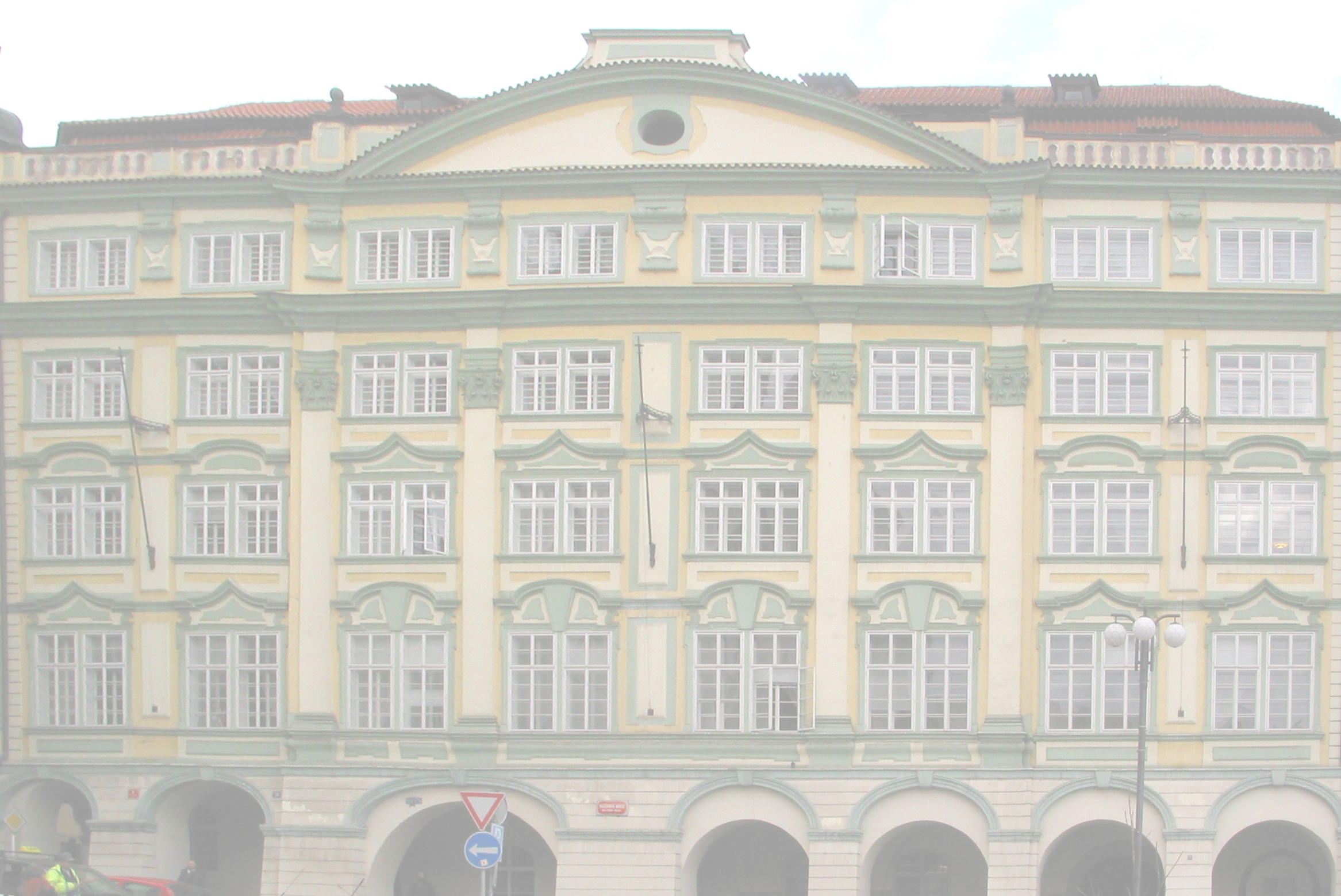eTraining for the Interpretation
of Man-made Scenes (eTRIMS)
2006 - 2009
Supported by the European Community under grant IST 027113
Consortium:
University of Bonn, Institute for Photogrammetry - Wolfgang Förstner (coordinator)
University of Hamburg - Bernd Neumann
Czech Technical University in Prague, Center for Machine Perception - Radim Sára
Imperial College London, Department of Electrical and Electronic Engineering - Maria Petrou
HITeC, Hamburg Informatics Technology Center - Lothar Hotz
eTRIMS home page
The eTRIMS Team in Hamburg:
| Bernd Neumann Johannes Hartz Arne Kreutzmann Kasim Terzic |
Department
of
Informatics, University of Hamburg |
| Lothar Hotz |
HITeC
Hamburg |
eTRIMS Research in Hamburg
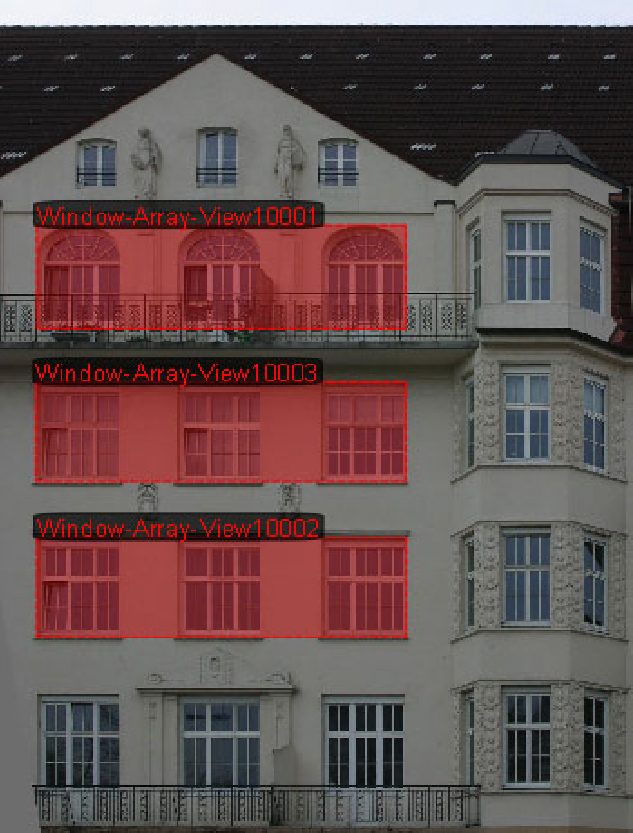 |
Scene
interpretation using learnt concepts The system SCENIC ("SCENe Interpretation by Configuration") has been extended in several ways to handle learnt concepts in low-level and high-level scene interpretation processes.
|
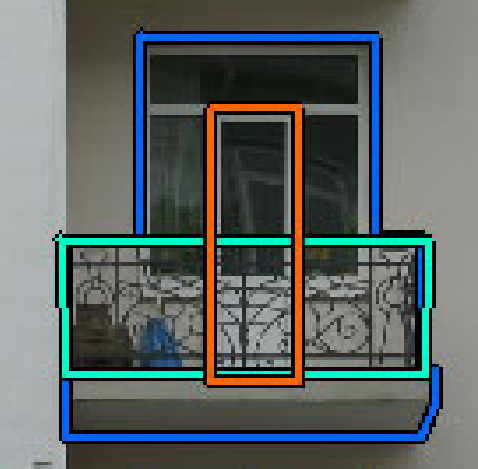 |
Version
Space Learning of spatial structures Conceptual descriptions of aggregates play an essential role in model-based scene interpretation. An aggregate specifies a set of objects with certain properties and relations which together constitute a meaningful scene entity. Aggregate concepts for spatially related objects can be learnt from positive and negative examples using Version Space Learning, introduced by Mitchell. Our approach features a rich representation language encompassing quantitative and qualitative spatial attributes and relations. Using examples from the buildings domain, we have shown that aggregate concepts for window arrays, balconies and other structures can in fact be learnt from annotated images and successfully employed in the conceptual knowledge base of a scene interpretation system. |
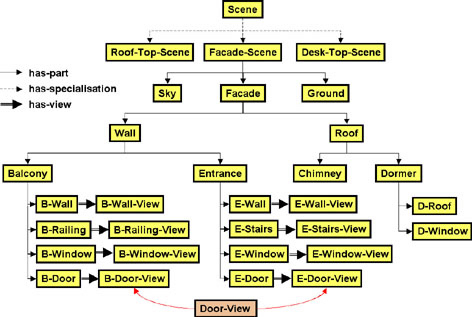 |
Probabilistic models for compositional hierarchies In the scene interpretation system SCENIC, high-level
knowledge about visual scenes is currently represented by means of a
logic-based knowledge representation language, using taxonomical and
compositional hierarchies. We are developing a probabilistic framework
which can be combined with our hierarchical knowledge structures. It
will support probabilistic learning methods for high-level
structures
such as building facades, and provide probabilistic guidance for
stepwise scene interpretation.
By imposing intuitive abstraction properties on compositional
hierarchies, evidence propagation during the interpretation process may
become computationally feasible even in large knowledge bases. |
   |
Context-aware Classification |
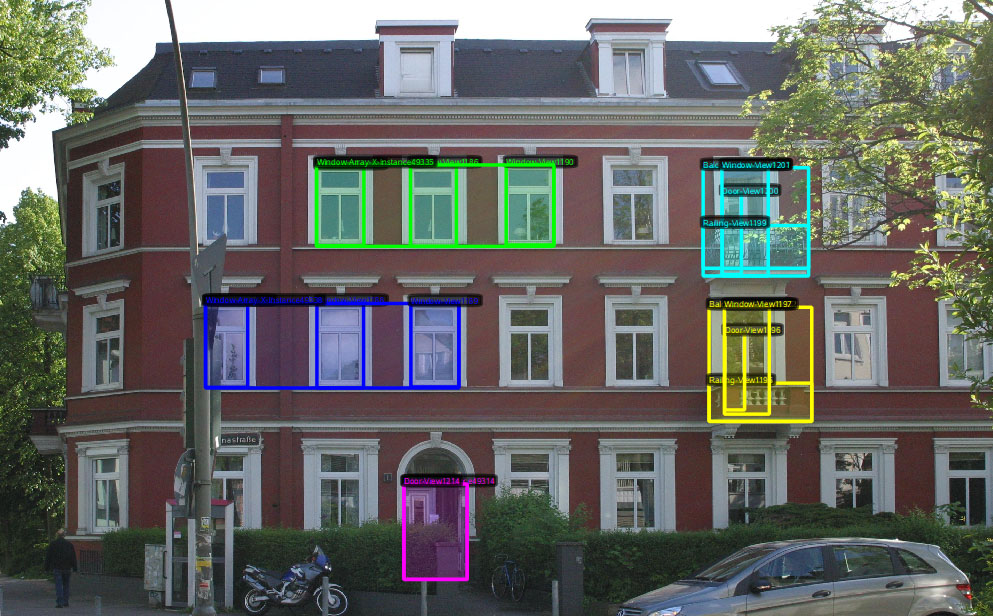 |
Learning Probabilistic Structure Graphs A novel domain-independent method for learning the probabilistic structure of 2D object configuration has been developed. The approach is graph-based and uses Maximum Common Subgraph Isomorphism to generalise a model graph over a set of training examples. A full probabilistic model, called a Probabilistic Structure Graph (PSG), is obtained by generalising the structural probabilities learnt from the examples. Models learnt from the eTRIMS image database have been used for classifying unknown object configurations, and an average classification rate of ca. 80% has been obtained. Additionally, bottom-up scene interpretation based solely on learnt models has been performed with promising results. |
Publications
| Terziç, K.; Hotz, L.; Sochman, J.: Interpreting Structures in Man-Made Scenes: Combining Low-Level and High-Level Structure Sources. In: Proc. International Conference on Agents and Artificial Intelligence (ICAART 2010), Valencia, January 2010 PDF |
| Terziç, K.; Neumann, B.: Integrating Context Priors into a Decision Tree Classification Scheme. In: Proc. International Conference on Machine Vision, Image Processing, and Pattern Analysis (MVIPPA 2009), Bangkok, December 2009 PDF |
| Hartz, J.: Learning
Probabilistic Structure Graphs for Classification and Detection of
Object Structures. To appear in: IEEE Proceedings of the International
Conference on Machine Learning and Applications, Miami (Florida, USA),
December 2009 PDF |
| Terzic, K., Neumann, B.: Decision Trees for Probabilistic Top-down and Bottom-up Integration. Report FBI-HH-B-288/09, Department of Informatics, University of Hamburg, 2009 PDF |
| Kreutzmann, A.; Terziç,
K.; Neumann, B.: Context-aware Classification for Incremental Scene
Interpretation. In: Proc. Workshop on Use of Context in
Vision Processing (UCVP 2009), Boston, Nov 2009 PDF |
| Hartz, J.; Hotz, L.; Neumann, B.; Terzic, K.: Automatic Incremental Model Learning for Scene Interpretation. Proceedings of the International Conference on Computational Intelligence (IASTED CI-2009), Honolulu (Hawaii, USA), August 2009 PDF |
| Hotz, L.; Neumann, B.; Terzic, K.: High-level Expectations for Low-level Image Processing. Proc. KI-2008, Springer, 2008 PDF |
| Neumann, B.: Bayesian Compositional Hierarchies - A Probabilistic Structure for Scene Interpretation. Report FBI-HH-B-282/08, Department of Informatics, Hamburg University, 2008. Revised (Section 6) Dec. 2008 PDF |
| Möller, R.; Neumann, B.:
Ontology-Based Reasoning Techniques for
Multimedia Interpretation and Retrieval. In: Y. Kompatsiaris, P. Hobson
(Eds.): Semantic Multimedia and Ontologies: Theory and Applications,
Springer 2008, 55-98 PDF (final draft) |
| Hartz, J.; Neumann, B.: Learning a Knowledge Base of Ontological Concepts for High-Level Scene Interpretation. International Conference on Machine Learning and Applications, Cincinnati (Ohio, USA), December 2007 PDF |
| Terzic, K.; Hotz, L.; Neumann, B. : Division of Work During Behaviour Recognition - The SCENIC Approach. Workshop on Behaviour Monitoring and Interpretation, KI-2007 PDF |
| Hartz, J.; Neumann, B.: Version Space Learning of Spatial Structures for High-Level Scene Interpretation. TR FBI-B-277/07, Department of Informatics, University of Hamburg, 2007 PDF |
| Hotz, L.; Neumann, B.; Terzic, K.; Sochman, J.: Feedback between Low-Level and High-Level Image Processing. TR FBI-B-278/07, Department of Informatics, University of Hamburg, 2007 PDF |
